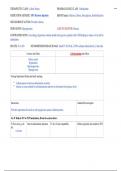THERAPEUTIC CLASS: Caloric Source PHARMACOLOGIC CLASS: Carbohydrate
MEDICATION (GENERIC): 50% Dextrose Injection (BRAND name): Glucose, Glutose, Insta-glucose, Insulin Reaction
MECHANISM OF ACTION: Provides Calories
INDICATIONS: Hypoglycemia LABS TO MONITOR: Glucose
CONTRAINDICATION: Corn allergy, hypertonic solution should not be given to patients with CNS bleeding or anuria or if at risk for
dehydration
ROUTES: IV or PO RECOMMENDED DOSAGE RANGE: Adult IV: 20-50 mL of 50% solution infused slowly (3 mL/min)
Common side-effects Life-threatening side effects
Fluid overload
Hypokalemia
Hypomagnesemia
Hyperglycemia
Nursing Implications/Patient and family teaching:
• Explain purpose of dextrose administration to patient
• Instruct on correct method for self-administration and how-to self-monitor blood glucose levels
Interactions: Antidote/Reversal agents:
Will alter requirements for insulin or oral hypoglycemic agents in diabetic patients
For IV fluids & IVP or IVPB medications, fill out the sections below:
IV flow rate (e.g. ml/ Rate of administration (minutes) IV site (Y-site) compatibility Dilution (typically only needed for IVP)
hr):
3 mL/min
, NURS 3512 DRUG CARD
Therapeutic class of drug: Non-opioid Analgesic/Antipyretic Pharmacologic class of drug: Para-aminophenol Derivative Pregnancy Cat
B
MEDICATION (GENERIC name): Acetaminophen (BRAND name): Tylenol
MECHANISM OF ACTION: Inhibits synthesis of prostaglandins in the CNS that may serve as mediators of pain and fever
INDICATIONS: Mild to moderate pain; fever
CONTRAINDCATION: Hepatic impairment/active liver disease; alcohol LABS TO MONITOR: AST/ALT ROUTES: PO, IV,
Rectal RECOMMENDED DOSAGE RANGE: Adult IV & PO: 1000 mg/6 hr or 650 mg/4 hr & 325-650 mg/6 hr or 1 g 3-4 times daily, Pedi: 80mg
(4-11 months)dig
Common side-effects Life-threatening side effects
Fatigue (IV) Hepatotoxicity
Hypokalemia (IV) Acute Toxicity: nausea/vomiting, diarrhea, sweating, hepatic failure
Renal Failure (high doses/chronic use) Stevens-Johnson syndrome: rash, fever, muscle aches
Nausea/Vomiting/Headache
Nursing Implications/Patient and family teaching:
• Do NOT exceed 4 g/day
• Only take 1 product with acetaminophen at a time and double check label on OTC meds
• Avoid alcohol while taking this medication
PA: Assess for Steven Johnson’s (rash, fever, general malaise, muscle ache), assess for signs of hepatotoxicity (yellowing of skin, sclera,
anorexia)
Interactions: Antidote/Reversal agents:
Warfarin (increase risk of bleeds)
Avoid Alcohol (can lead to liver toxicity) Acetylcysteine
Use with NSAIDS increases the risk of adverse renal effects
Concurrent use of isoniazid, rifampin, rifabutin, phenytoin, barbiturates and carbamazepine may
increase risk of liver damage
Propranolol may decrease metabolism and increase drug effects
For IV fluids & IVP or IVPB medications, fill out the sections below:
,IV flow rate (e.g. ml/ Rate of administration (minutes): IV site (Y-site) compatibility: Dilution (typically only needed for IVP)
hr) Infuse over 15 minutes Not compatible with:
• Acyclovir, chlorpromazine,
diazepam, metronidazole
, THERAPEUTIC CLASS: Non-opioid Analgesic/Antipyretic PHARMACOLOGIC CLASS: Para-aminophenol Derivative
MEDICATION (GENERIC name): Acetaminophen w/ Codeine (BRAND name): Tylenol w/ Codeine #3
MECHANISM OF ACTION: Inhibits synthesis of prostaglandins in the CNS that may serve as mediators of pain and fever
INDICATIONS: Mild to moderate pain; fever
CONTRAINDICATION: Hepatic impairment/active liver disease; alcohol
ROUTES: PO, IV, Rectal LABS TO MONITOR: AST/ALT
RECOMMENDED DOSAGE RANGE: Adult IV & PO: 1000 mg/6 hr or 650 mg/4 hr & 325-650 mg/6 hr or 1 g 3-4 times daily, Pedi: 80mg (4-11 months)
Common side-effects Life-threatening side effects
Fatigue (IV) Hepatotoxicity
Hypokalemia (IV) Acute Toxicity: nausea/vomiting, diarrhea, sweating, hepatic failure
Renal Failure (high doses/chronic use) Stevens-Johnson syndrome: rash, fever, muscle aches
NARCS U; headache
Nursing Implications/Patient and family teaching:
• Do NOT exceed 4 g/day
• Only take 1 product with acetaminophen at a time and double check label on OTC meds
• Avoid alcohol while taking this medication
PA: Assess for Steven Johnson’s (rash, fever, general malaise, muscle ache), assess for signs of hepatotoxicity (yellowing of skin, sclera,
anorexia)
Interactions: Antidote/Reversal agents:
Warfarin (increase risk of bleeds)
Alcohol (can lead to liver toxicity) Acetylcysteine/Naloxone
Use with NSAIDS increases the risk of adverse renal effects
Isoniazid, rifampin, rifabutin, phenytoin, barbiturates and carbamazepine may increase risk of liver
damage
Propranolol may decrease metabolism and increase drug effects
For IV fluids & IVP or IVPB medications, fill out the sections below:
IV flow rate (e.g. ml/ Rate of administration (minutes): IV site (Y-site) compatibility: Dilution (typically only needed for IVP)
hr) Infuse over 15 minutes Not compatible with:
• Acyclovir, chlorpromazine,
diazepam, metronidazole




